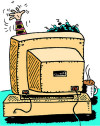Brandy redux
Posts: 2376
Joined: 2/7/2007
Status: offline

|
If all the suggestions above fail to solve your computer lockup/freeze problem, check your RAM, free hard drive space and Page File (Virtual Memory) settings. Since Virtual Memory acts as an extension of RAM when a process requires more memory than there is RAM, it is critically important to have enough free hard drive space for Virtual Memory.
First, determine how much free hard drive space is available on the C:\ drive. To do so, go to My Computer (Computer for WinVista & Windows 7), right click on the C:\ drive, then select 'Properties' in the menu that drops down. A window should open which displays the amount of Used Space and Free Space. Make a note of the total number of GB in the 'Free Space' section.
Second, determine how much RAM is installed on your computer. To do so, go to 'Control Panel' then click (or double-click) on 'System'. When the 'System Properties' window opens, click on the 'General' tab (if it is not already selected). On the General tab, and in the 'Computer' section ('System' section for Vista & Windows 7), you should see how much RAM is installed on your computer.
If you find that the amount of 'Free Space' is not EQUAL TO or LARGER THAN 1 1/2 times the amount of installed RAM (preferably 3 times the amount of installed RAM), you may not have enough free hard drive space for a proper Page File (Virtual Memory). In that case, the best option would be to free up hard drive space - either by conducting the computer cleanup recommended in the message above or uninstalling software that is no longer used. HOWEVER, if you have more than one drive on your computer, you'll want to FIRST follow the steps below to make sure that the paging file isn't set for a drive other than the C:\ drive.
While you are still on the General tab of System Properties, click on the Advanced tab (for Vista & Windows 7, click on the 'Advanced System Settings' link).
On the Advanced tab, click on the 'Settings' button in the 'Advanced' section (do NOT click on the 'Settings' button in either the 'User Profiles' or 'Startup and Recovery' section). (for Vista & Windows 7, click on the 'Settings' button in the 'Performance' section)
When the 'Performance Options' window opens, click on the 'Advanced' tab.
On the Advanced tab, and in the 'Virtual Memory' section, click on the 'Change' button.
When the 'Virtual Memory' window opens, check which item is selected in the 'Paging file size for selected drive' section.
If you see that 'System Managed Size' is selected, no further action is required (provided the free hard drive space on the C:\ drive is AT LEAST 1 1/2 times the amount of installed RAM). Just click on OK to exit all windows.
If you see that 'No paging file' is selected for the C:\ drive, you will definitely want to select either 'Custom size:' or 'System Managed Size' - because it is NEVER a good idea for the C:\ drive to be set to 'No paging file'. HOWEVER, it is not absolutely mandatory for the paging file to be on the C:\ drive. So, if you have more than one drive on your computer, and you see that one of the other drives is set to have a paging file, select that drive, then check the paging file settings for that drive.
If you see that 'Custom size:' is selected, check the 'Initial Size (MB):' and 'Maximum Size (MB):' settings. Also check the MB setting in 'Recommended:' at the bottom of the window. Under normal conditions, the 'Recommended:' size will be roughly 1 1/2 times the amount of installed RAM. So, the 'Initial Size (MB):' should NOT be smaller than the 'Recommended:' size. If it is, change it. And, to be sure to have a proper paging file, it couldn't hurt to set the 'Maximum Size (MB):' to AT LEAST 3 times the amount of installed RAM. And, if you have plenty of hard drive space, you could set BOTH 'Initial Size (MB):' and 'Maximum Size (MB):' to AT LEAST or MORE THAN 3 times the amount of installed RAM. After making any changes to either 'Initial Size (MB):' or 'Maximum Size (MB):', click on the 'Set' button. Then, click on OK to exit all windows. When you are back at the desktop, restart the computer.
NOTE: 1 GB is equal to 1024 MB.
Hopefully, the changes you made will either eliminate or minimize the computer lockups/freezes.
< Message edited by Brandy redux -- 12/25/2009 8:02:24 PM >
_____________________________
For More Help: Click on the FAQ link at the top of this page Then, click on the All FAQ's button on the next page To contact me by email, please send your message to pine_97@yahoo.com |

 Printable Version
Printable Version





 New Messages
New Messages No New Messages
No New Messages Hot Topic w/ New Messages
Hot Topic w/ New Messages Hot Topic w/o New Messages
Hot Topic w/o New Messages Locked w/ New Messages
Locked w/ New Messages Locked w/o New Messages
Locked w/o New Messages Post New Thread
Post New Thread